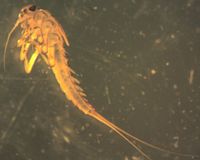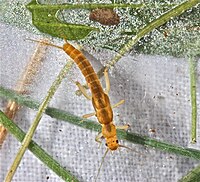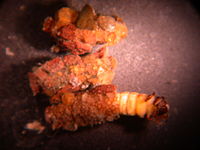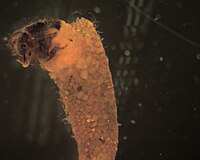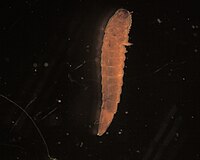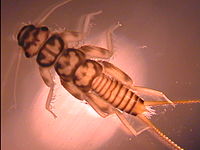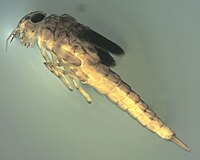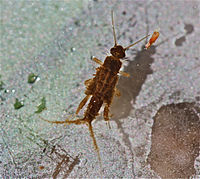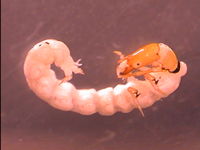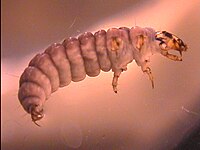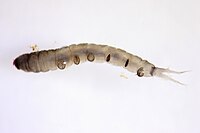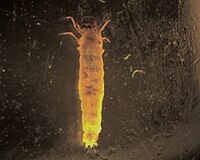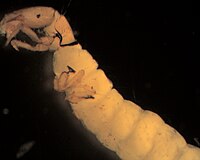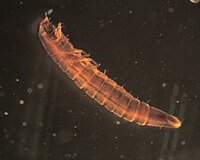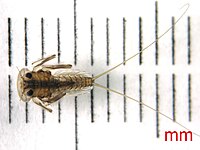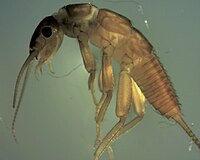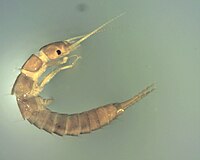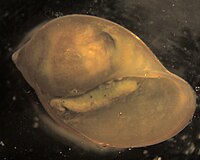Vermont EPSCoR's Streams Project; A Teacher Collaboration on WikiEducator
Openly shared content, practices, and developing resources from Vermont EPSCoR's Streams Project. Join this collaboration and make a difference!
 Locust Creek |
|---|
|
| Stream code: | WR_ThchrBrk_1251 |
| Basin: | Winooski River |
| State or Province: | Vermont |
| Country: | USA |
| Latitude: | 44.39871563 |
| Longitude: | -72.67622545 |
| School: | Saint Michael's College |
The following are the most common invertebrates collected from this stream site.
Baetis
- Order
- Ephemeroptera
- Family
- Baetidae
- Genus
- Baetis
- Common name
- The Little Olive
- Tied fly
- Sawyer Pheasant Tail Nymph
This mayfly has three "tails" and a unique head shape. Its gills are oval shaped and insert dorsally. More mature nymphs have long, dark wing pads.
Image of the long, dark wing pads.
Chironomidae
- Order
- Diptera
- Family
- Chironomidae
- Common name
- Nonbiting midge
- Tied fly
- Griffith's Gnat
Midge larvae tend to be the most common macroinvertebrate at our sites. As with other Diptera, there are no true jointed legs. Chironomidae do have a pair of prolegs at each end and preserved individuals tend to curl into a 'C'. Identification past family requires slide-mounted heads. We have seen philopotamid caddisflies misidentified with the chironomids and we suspect that that happens when samples are being sorted from trays. Under a microscope, six prominent legs can be seen on members of the caddisfly family Philopotamidae.
More information on Philopotamidae.
Leuctra
- Order
- Plecoptera
- Family
- Leuctridae
- Genus
- Leuctra
This family of stonefly is fairly slender by stonefly standards. The divergent wing pads are a helpful characteristic. Leuctridae are similar in overall shape to the Capniidae; however, Leuctridae often do not have pleural folds. If they are present, they only extend from abdominal segments 1-7.
Leuctra are recognized by abdominal terga with posterior fringes of short hairs and last few segments with longer hairs.
Image of the divergent wing pads.
Neophylax
- Order
- Trichoptera
- Family
- Uenoidae
- Genus
- Neophylax
- Common name
- Fool's Caddis
- Tied fly
- Peeping Caddis
Neophylax are characterized by having a sclerotized pronotum and mesonotum. They build a case of coarse sand grains often with a pair of latteral pebbles or "ballast stones". The larvae are rather stout and the head is scrunched in between the limbs. The anal hooks are attached directly to the abdomen and they rarely come out of the case when preserved. On the ventral surface of the abdominal segments, one can see darkened ovals, known as the chloride epithelia. Like the
Limnephilidae, they have a prosternal horn, though it can sometimes be small. Also, they have a dorsal hump and two lateral humps on the first abdominal segment- be careful! Often times, these features can be
squished down or damaged in the sampling process. A larva removed from it's case is shown
here.
The feature that distinguishes Uenoidae from Limnephilidae is the mesonotum: on either side of the midline, the anterior margin is notched.
Because our samples were taken in summer, we found large numbers of Neophylax pre-pupae. We anticipate that there will be fewer present in the streams in late September and many of those sampled will be at the pupal or adult stage. Samples taken in October would tend to have more empty cases.
Apatania
- Order
- Trichoptera
- Family
- Apataniidae
- Genus
- Apatania
Members of this caddisfly family will likely all belong to the genus
Apatania as it is the only one documented to occur in Vermont rivers. Apataniidae have lateral and dorsal humps. Like the Limnephilidae and the Uenoidae, they have a prosternal horn; this feature is challenging to see in
Apatania (or we would have provided a photograph). The most distinguishing feature of
Apatania is the row of sa1 setae across the metanotum. Also, their cases are hard and always made of small minerals.
Images of the row of sa1 setae and their cases.
More information on the families Limnephilidae and Uenoidae.
Optioservus
- Order
- Coleoptera
- Family
- Elmidae
- Genus
- Optioservus
The larvae of
Optioservus have open coxae, as determined by the straight definition between segments on the ventral side of the pronotum.
The adult Optioservus have a compact appearance, especially the head and thorax. There are also dorsal ridges and a characteristic diamond-shaped sutellum observable in the dorsal view.
Images of the straight definition between segments, the dorsal ridgesand the diamond-shaped scutellum.
Agnetina
- Order
- Plecoptera
- Family
- Perlidae
- Genus
- Agnetina
Agnetina nymphs have cylindrical, striped abdomens. Like other Plecoptera, they have 2 tails and 2 claws on each tarsus. This genus has three black dots (ocelli) on the top of the head. Click to see the
three ocelli on the dorsum of the head (3 black dots at joint with the pronotum). This stonefly is characterized by the
filamentous gills located in the "armpits". Another important feature is the paraglossae and glossae extending different lengths. The
occiput has a transverse row of evenly spaced little hairs.
Agnetina has another row of evenly spaced hairs on the posterior edge of
abdominal segment 7.
Pseudocloeon
- Order
- Ephemeroptera
- Family
- Baetidae
- Genus
- Pseudocloeon
- Tied fly
- Bluewinged Olive
Mayflies in this genus have a distal lobe on their antennal scapes, and the second segment of labial palps has an expanded medial process. Villopores are absent on legs.
Click to see the antennal scapes. The dorsal and ventral views can be seen here.
Amphinemura
- Order
- Plecoptera
- Family
- Nemouridae
- Genus
- Amphinemura
We rarely encounter this stonefly genus.
Philopotamidae
- Order
- Trichoptera
- Family
- Philopotamidae
- Common name
- fingernet caddisflies
Philopotomidae are net-spinning filtering collectors. A casual observer might sort them with Chironomidae, but a close look reveals six jointed legs. The faint white 'T' shaped labrum extending from the front of the head past the mandibles is diagnostic for the family (it is sometimes withdrawn and hard to see).
Image of the faint white 'T' shaped labrum. Common genera include Dolophilodes, Wormaldia, and Chimarra.
Rhyacophila
- Order
- Trichoptera
- Family
- Rhyacophilidae
- Genus
- Rhyacophila
- Common name
- Green Caddis
- Tied fly
- Henryville Special or Glass Bead Caddis
In our lab,
Rhyacophila is known as the "Michelin Man" due to its large banded body. It has a very obviously checker-patterned head. It also has terrifying anal claws with large accessory hooks.
Links to images that may be useful if you have a magnifying glass or microscope:
Checker-patterned head.
Anal claws with large accessory hooks.
Antocha
- Order
- Diptera
- Family
- Tipulidae
- Genus
- Antocha
This small dipteran in the cranefly family is quite common. It is distinguished from most other dipterans we found by the 'creeping welts' that appear as prominent dark stripes along the abdomen. The dark head is usually partly exposed; however, it can be pulled back into the thoracic cavity during preservation.
Lepidostomatidae
- Order
- Trichoptera
- Family
- Lepidostomatidae
- Common name
- The Little Plain Brown Sedge
- Tied fly
- Elk Hair Caddis
These have lateral humps on the first abdominal segments, but lack a dorsal hump. The dorsal of the first two thoracic segments are sclerotized. They are frequently found in four-sided cases made of square pieces of detritus.
Images of the first two thoracic segments and the four-sided cases.
Wormaldia
- Order
- Trichoptera
- Family
- Philopotamidae
- Genus
- Wormaldia
Stenelmis
- Order
- Coleoptera
- Family
- Elmidae
- Genus
- Stenelmis
The larvae of
Stenelmis, as in
Ordobrevia, have a sternum on the ventral side of the pronotum. The main difference between the two genera is in the antennae the second segment is less than twice as long as the first in
Stenelmis.
The adult Stenelmis has a clear separation between the thorax and abdomen as well as a more distinctly separate head as compared to other genera.
Click here to see pictures of the sternum and
antennae-
Heptageniidae
- Order
- Ephemeroptera
- Family
- Heptageniidae
- Common name
- flatheaded mayfly
- Tied fly
- Light Cahill, Wingless Pale Evening Dun
This family of mayflies can be characterized by their distinctly flattened heads and striking resemblance of the character 'Jack Skellington' from the movie 'The Nightmare Before Christmas.' This family can either have two or three cerci (tails).
Commonly encountered genera include:
Epeorus
Heptagenia
Maccaffertium
Rhithrogena
Capniidae
- Order
- Plecoptera
- Family
- Capniidae
- Common name
- winter stonefly
Capnia stoneflies have hind wing pads that are are broad as they are long. An important distinction of the Capniidae family is the membranous pleural folds that run down the posterior abdomen segments 1-9. These look like two lines running parallel down the back of the abdomen.
Capnia are distinguished by femurs and tibia of forelegs with less than 20 fine hairs and no dorsal femoral fringe hairs.
Ventral and dorsal views are seen here.
Perlodidae
- Order
- Plecoptera
- Family
- Perlodidae
Stoneflies in the Perlodidae family do not have branching gills from leg bases. When observing their mouthparts, the glossae and paraglossae form a large three-pronged notch, or opening. The hind wing pads are divergent. Cerci, or "tails," are as long or longer than the abdomen.
Images of mouthparts, thehind wing pads and the ventral view.
Physidae
Members of the family Physidae belong in the class of Gastropoda. Members contain a single, coiled shell with a left handed spiral going counterclockwise. Belonging to the family of aquatic pulmonates, members breathe air using a structure similar to a lung.
Images of the family Physidae, the class of Gastropodaand a shell with a left-handed spiral.
These sites are built by sampling specific streams and making a list of the invertebrates detected. A series of templates contain the photo and description of many of the common insects we have sampled in 100+ streams in Vermont and elsewhere. But there are less common insects for which we have not yet built templates and those we list at the end of a stream page. In Locust Creek we found the following insects in addition to those listed above:
Curculionidae
Petrophila
Pseudostenophylax
Cingymula
Rhagovelia

